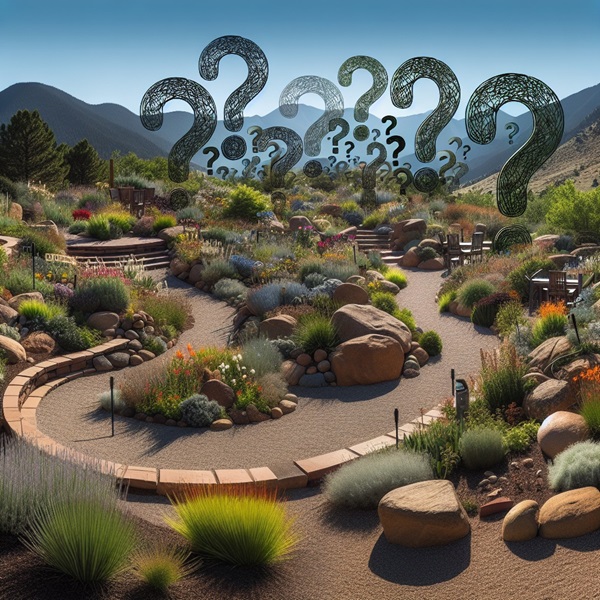
Key Takeaways
- Choose plants that thrive with minimal water to conserve resources and save time.
- Improve your soil to enhance water retention and support plant health.
- Reduce lawn areas to cut down on water use and maintenance.
- Opt for native plants that are adapted to your local climate and require less care.
- Utilize mulch and efficient irrigation to maintain a beautiful xeriscape garden.
The Seven Principles of Xeriscaping:
Principle 1: Water Conservation
When it comes to xeriscaping, the cornerstone is water conservation. This isn’t just about saving water; it’s about creating a sustainable garden that flourishes even in dry conditions. You’ll want to start with plants known for their drought tolerance. These are the stalwarts that once established, sip water instead of guzzling it. The key is to look beyond the cacti – many plants have evolved to manage with less hydration.
Choosing Plants with Low Water Needs
So, what should you plant? Begin with native species. These plants have adapted to local conditions over thousands of years and are naturally more resilient with less water. Besides that, consider their natural habitat – plants from arid regions are a natural fit. For example,
- Lavender – with its soothing scent and purple blooms, it’s not just beautiful but also highly drought-tolerant.
- Rosemary – a culinary favorite that doubles as an attractive, water-wise shrub.
Then there’s the ornamental grasses. They provide texture and movement to your garden. Mexican Feather Grass and Blue Fescue are perfect picks, offering visual interest with hardly any water needs.
- Mexican Feather Grass – its fine, hair-like foliage dances in the breeze and requires minimal water.
- Blue Fescue – this grass adds a splash of blue and is tough as nails when it comes to drought.
Understanding Plant Watering Cycles
It’s crucial to understand the watering needs of your plants. Once established, many drought-tolerant plants prefer a deep soak less frequently rather than regular light watering. This encourages deep root growth and helps plants become more self-sufficient. Therefore, in the beginning, you’ll need to water more often to help the plants get established, but over time, you’ll water less and less.
Principle 2: Soil Improvement
Soil that holds onto moisture without becoming waterlogged is a game-changer in xeriscaping. You can improve your soil by adding organic matter like compost, which not only retains moisture but also improves soil structure and provides nutrients to your plants.
Amending Soil for Better Water Retention
To start, perform a simple test to see if your soil is sandy or clay-heavy. Sandy soil drains quickly but doesn’t hold nutrients well, while clay soil retains water and nutrients but can become compacted. Amending either type with compost will help balance these traits for optimal plant growth.
Example: If you have sandy soil, mix in well-rotted compost to increase its ability to hold water. For clay soil, compost will help to break it up and improve drainage.
It’s also wise to add a layer of mulch on top of the soil around your plants. Mulch reduces water evaporation, keeps the soil cooler, and reduces weed growth, which competes with your plants for water.
Identifying Soil Types and Matching Plant Preferences
Choose plants that are well-suited to your soil type for the best chance of success. Some plants, like Yarrow and
- Yarrow – adapts to a variety of soils and offers a burst of color with its clustered flowers.
- Sedum – a low-maintenance succulent that comes in many varieties and thrives in challenging conditions.
Remember, the right plant in the right place is the mantra of xeriscaping. It’s about working with nature, not against it.
Principle 3: Limited Turf Areas
Expansive green lawns are water guzzlers. In a xeriscape, the idea is to minimize the amount of turf to reduce water usage. This doesn’t mean you have to give up on green spaces, but rather, you get creative with them. Consider turf alternatives like low-growing ground covers that provide a lush look with a fraction of the water requirement.
Exploring Alternatives to Traditional Grass Lawns
Ditch the traditional lawn for ground covers like Thyme or Stonecrop. These plants spread to form a living carpet that’s as beautiful as it is resilient. Besides that, they’re tough enough to handle light foot traffic and come in a variety of textures and colors to complement any garden design.
- Creeping Thyme – emits a delightful fragrance when stepped on and thrives in sunny spots.
- Stonecrop – offers succulent leaves and vibrant flowers, perfect for adding interest to your xeriscape.
Another great option is to use ornamental grasses or even artificial turf in areas where you desire the look of traditional grass without the maintenance.
Incorporating Hardscaping Elements for Reduced Water Usage
Using hardscaping elements like stones, pavers, and gravel can further reduce your garden’s water needs. They add texture and contrast to your xeriscape and, most importantly, require no watering at all. Arrange them artistically to create walkways, patios, or as decorative elements among your drought-resistant plants.
Principle 4: Using Native Plants
Native plants are the superheroes of the xeriscape garden. They’re already adapted to your local climate and soil conditions, which means they’re more likely to thrive with minimal intervention.
Benefits of Choosing Locally Adapted Flora
When you choose native plants, you’re not just making your life easier. You’re also supporting the local ecosystem. These plants provide essential food and habitat for native wildlife like birds, bees, and butterflies. Because they’re adapted to the local environment, they resist pests and diseases better, reducing the need for chemicals in your garden.
How to Source and Select Native Plant Species
Start by visiting local nurseries that specialize in native plants. The staff there can offer invaluable advice on which plants will work best in your garden. You can also connect with local gardening groups or extension services for recommendations. When selecting plants, consider their mature size, bloom time, and any specific site requirements they might have to ensure they’ll thrive in your xeriscape.
Principle 5: Practical Mulching
Mulching is an essential practice in xeriscaping. It helps retain soil moisture, suppresses weeds, and can even add nutrients back into the soil as it breaks down.
Types of Mulch Suitable for Xeriscaping
For xeriscaping, organic mulches like wood chips, straw, or leaves are ideal. They not only retain moisture but also improve soil quality over time. Gravel and rock can also be used as mulch, especially in succulent gardens, as they reflect heat away from the plants and minimize water loss.
Mulching Techniques to Preserve Moisture
Apply a thick layer of mulch, about 2-3 inches, around your plants, but be careful not to pile it up against the stems or trunks, as this can cause rot. Mulch should extend to the drip line of the plants, which is the area directly below the outermost reach of the branches. This ensures that the root zone is well covered, preserving moisture where it’s needed most.
Principle 6: Efficient Irrigation
Even in a xeriscape, some watering is necessary, especially during establishment or extended dry periods. However, the key is to do it efficiently.
Implementing Drip Irrigation for Targeted Watering
Drip irrigation is a xeriscaper’s best friend. It delivers water directly to the base of the plant, minimizing evaporation and runoff. This method is not only water-wise but also ensures that plants receive a deep, thorough watering, which promotes strong root growth.
Scheduling Irrigation to Optimize Plant Health and Water Use
Watering should be done early in the morning or late in the evening when temperatures are cooler to reduce evaporation. Also, adjust your watering schedule based on the season and current weather conditions. A rain sensor can be a valuable addition to your irrigation system, as it will prevent watering when it’s not necessary.
- Install a drip irrigation system for efficient watering.
- Water during cooler parts of the day to minimize evaporation.
- Use a rain sensor to avoid unnecessary watering.
With the right setup, your xeriscape garden will not only survive but thrive, with minimal water input.
Principle 7: Sustainable Maintenance
One of the often-overlooked aspects of xeriscaping is its sustainable maintenance practices, which are crucial for the long-term success of your water-wise garden.
Implementing Low-Maintenance Strategies
A key aspect of xeriscaping is selecting plants that require minimal care once established. This not only reduces the need for constant attention but also saves time and resources in the long run. Opt for species that are naturally resilient to pests and diseases, eliminating the need for chemical interventions.
Example: Choose plants like Russian Sage or Butterfly Bush that not only add beauty to your garden but also thrive with minimal maintenance.
Embracing Natural Processes
In a xeriscape garden, it’s beneficial to work with natural processes rather than against them. Allow fallen leaves to decompose and nourish the soil, reducing the need for additional fertilizers. Encourage beneficial insects and pollinators by providing habitat and avoiding chemical pesticides.
Example: Instead of raking up fallen leaves, consider leaving them in place as natural mulch, which will also help retain soil moisture.
Practicing Water-Wise Habits
Conserving water goes beyond efficient irrigation techniques. It also involves adopting water-wise habits in your gardening practices. Collect rainwater in barrels for use during dry spells, and avoid watering during windy conditions to minimize evaporation.
Example: Install a rain barrel to capture rainwater from your roof, which can then be used to irrigate your garden during drier periods.
By incorporating sustainable maintenance practices into your xeriscape garden, you can create a beautiful and eco-friendly landscape that thrives with minimal intervention.

Garden Idea: Succulent Showcase
Let’s talk succulents. These plants are practically synonymous with xeriscaping due to their incredible ability to store water. A succulent showcase in your garden can be both a visual treat and a testament to water-wise gardening.
Top Succulent Varieties for Your Xeriscape
Aloe Vera, with its medicinal properties, and Echeveria, with its rosette form, are standout choices. They’re not just resilient; they’re also striking in appearance. Consider the following:
- Aloe Vera – It’s not only good for burns but also makes a stunning architectural statement.
- Echeveria – Available in a range of colors and sizes, this succulent adds a sculptural element.
Design Tips for a Cohesive Succulent Garden
When designing your succulent garden, group plants with similar light and water requirements together. Create a tapestry of textures and colors by mixing different varieties. And don’t forget about containers – they’re perfect for showcasing individual specimens.
Garden Idea: The Rock Garden Retreat
Rock gardens are another classic xeriscape feature. They can turn an area that might otherwise be barren into a low-maintenance, high-impact space.
Choosing Rocks and Gravel for Aesthetics and Function
Select rocks that complement the natural landscape. Use gravel as both a decorative and functional element; it provides a permeable surface for water to infiltrate and reduces runoff.
Pairing Drought-Resistant Plants with Stony Landscapes
Plant drought-resistant species among the rocks to soften the hardscape and add life. Plants like Sedum ‘Angelina’ or Delosperma ‘Fire Spinner’ can fill in the gaps and create a beautiful, living mosaic.
Garden Idea: Native Plant Paradise
Creating a garden that celebrates native plants is a surefire way to ensure xeriscape success. These plants have evolved to thrive in your local conditions and can create a sanctuary for local wildlife.
Creating a Pollinator-friendly Xeriscape
Incorporate flowering natives like Penstemon or Coneflower to attract pollinators. These plants not only survive on less water but also help sustain bees, butterflies, and birds.
Mixing and Matching Plants for Year-Round Interest
Choose a variety of plants that bloom at different times to provide interest throughout the seasons. Evergreens can add structure and color even in the depths of winter.

Frequently Asked Questions
You’ve got questions, I’ve got answers. Let’s dive into some common queries about xeriscaping.
Can I incorporate vegetables into xeriscaping?
Yes, you can! Opt for drought-tolerant varieties and water them efficiently. Plants like Swiss chard, peppers, and certain tomato varieties can do well with less water.
How often should xeriscaping plants be watered?
Once established, many xeriscaping plants need water only once every few weeks, depending on your climate. The key is deep, infrequent watering that encourages deep root growth.
Are there colorful flowers that work well in a xeriscape?
Absolutely. Flowers like Gaillardia, also known as blanket flower, and Salvia offer vibrant colors and are drought-tolerant once established.
Can xeriscaping help attract wildlife?
Definitely. Xeriscaping with native plants provides food and habitat for local wildlife, turning your garden into a bustling ecosystem.
Is xeriscaping suitable for all climate types?
While xeriscaping is often associated with arid climates, the principles can be applied anywhere to reduce water usage and maintenance. It’s all about choosing the right plants for your specific environment.



